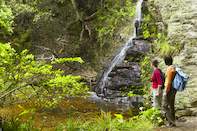
Garden Route National Park is a massive 157 000 hectares in size and incorporates thin stretches of coastline, lakes, mountains, forests and marine protected areas. Small streams rise up in the mountains and twist and wind their way down towards the ocean. Some of the streams have cut deep gorges into the rocks, as can be seen at Storms River. The mountain ranges in this area are all made up of hard quartzite from the Cape Fold Belt, similar to Table Mountain.
Along the coastline, especially towards the east one will see high barrier sand dunes, some of which, like at the Keurbooms River, climb to 200 - 300 metres high. Beautiful lush green mountain faces are covered in fynbos on their southern sides where water and rainfall occurs more frequently while the northern faces are drier as the cliffs fall into the rainfall shadow.
Fynbos and forest are the two dominant types of vegetation in the area. You will find plantations of exotic timber trees in certain areas but the indigenous forest is scattered throughout the region, through the mountains and along the coastline. The National Park holds the largest extent of indigenous forest in South Africa with the biggest section being found in an almost continuous arc that starts near Wilderness and moves inland and upwards towards just west of Plettenberg Bay.
Ancient Indigenous Forest
The forest, which spans some 43 500 hectares is made up of tall and multi-layered trees including Outeniqua yellowwood, South Africa's tallest tree, growing up to 60 metres in height. Two other giants include real yellowwoods and stinkwoods, both of which were once in great demand as they provide excellent timber. In the wetter areas of the forest one will find common tree ferns, cape wild banana and white strelitzias. Throughout the forest there is a dense layer of low bushes, shrubs and many different ferns which, when all combined creates as magical green, carpeted wonderland.
Fynbos covers an expanse of 80 000 hectares and its diversity is rich and impressive. The fynbos differs based on its location, type of soil in the area and the amount of rainfall. On the southern slopes, west of the Keurbooms River, one will find South Outeniqua sandstone fynbos while the northern slopes have a drier form. The lower slopes, especially in the west one will find Garden Route shale fynbos and from its fringes all the way to the coast Knysna sand fynbos occurs. More than 30 species of proteas are found in the nature reserve, including long-bud sugarbush, blue sugarbush and yellow-bushes.
Many species of heath or erica can also be found in the national park with several being easily seen growing alongside the road. The most obvious erica is the is the 2 metre tall Erica canaliculata which has small pink bell flowers. Bietou or bush-tick berry, identified between May and October by its canary yellow flowers, grows abundantly in the sands along the coastal plains.

 The Tsitsikamma National Park, part of the Garden Route National Park in South Africa, is a place where you can experience the outdoors, stu...
The Tsitsikamma National Park, part of the Garden Route National Park in South Africa, is a place where you can experience the outdoors, stu... Wilderness National Park is situated in the heart of the Garden Route, South Africa. It is a fascinating combination of rivers, lakes, estua...
Wilderness National Park is situated in the heart of the Garden Route, South Africa. It is a fascinating combination of rivers, lakes, estua...